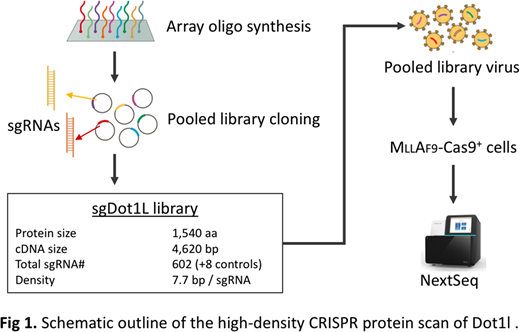Abstract
Leukemias containing Mixed Lineage Leukemiagene rearrangement (MLL-r) account for 5-10% of human acute leukemia cases and are associated with a poor prognosis. The unmet clinical need and the lack of an effective targeted therapy emphasizes the need for novel approaches for these malignancies.Recent studies have discovered an essential role for the histone H3 lysine 79 (H3K79) methyltransferase DOT1L in the maintenance of MLL-r leukemias. Phase-I clinical trials (NCT01684150 and NCT02141828) have demonstrated the safety and clinical activity of the DOT1L-specific small molecule inhibitor EPZ5676 (Pinometostat, Epizyme Inc.). However, the variable response of the MLL-r patients in these clinical trials indicates the need to further understand the mechanism of action and resistance to DOT1L inhibitors.
To address this issue, we designed a high-density CRISPR screen approach (Fig 1) to dissect the function of Dot1l coding regions in mouse MLL-AF9 leukemic cells, a well-established mouse model that mimics human MLL-r acute myeloid leukemia (AML). We constructed a library of 602 sgRNA that targets most of the "NGG" protospacer adjacent motifs (PAM) within Dot1l exons. The average targeting density is 7.7 bp per sgRNA (i.e. 2.5 a.a. per sgRNA). We delivered this sgRNA library into Cas9-expressing MLL-AF9 AML cells using lentiviral transduction, and then compared the frequencies of each integrated sgRNA sequence before vs. after 12 days of culture using high-throughput sequencing (NextSeq, Illumina Inc.). The results revealed a significant depletion of clusters of sgRNA targeting the known functional regions including the lysine methyltransferase (KMT) core and the AF9-binding domains of DOT1L. We mapped the CRISPR scan score to the previously solved three-dimensional structures of DOT1L and found the high-density CRISPR scan clearly distinguishes the substrate binding pocket from the less important regions within the KMT domain. Furthermore, we identified CRISPR hotspots that coincide with amino acid residues directly contacting the enzymatic substrate S-adenosylmethionine (SAM). Similarly, CRISPR scan identifies amino acid hot spots in DOT1L that establish a direct interaction with the cofactor AF9. These results implicate the utility of the high-density CRISPR scan to pinpoint the functional elements within a protein to a sub-domain resolution.
To identify regions in DOT1L that mediate response of MLL-r leukemia to DOT1L-inhibitors, we conducted parallel CRISPR scans by culturing the Dot1l sgRNA library transduced MLL-AF9-Cas9+cells in either DMSO (vehicle) or the DOT1L inhibitor (1 uM EPZ5676) for 12 days. These paired screens revealed distinct patterns of the CRISPR scan scores between the two culture conditions. Surprisingly, a cluster of 31 sgRNA targeting the amino acid residues T560 - S661 of DOT1L was significantly enriched only in the presence of the DOT1L inhibitor.Expression of individual sgRNA targeting this region confirmed the EPZ5676-resistant phenotype observed in the CRISPR scans. Computational modeling of the structure of DOT1L suggests this newly identified region overlaps with two alpha-helixes motifs in a predicted coiled-coil domain. Finally, we examined eight clinically observed DOT1L missense mutations in this region (cBioPortal database; 54,510 patients) and foundthree DOT1L-mutant constructs (A591V, G594S and L626P) when expressed in the MLL-AF9 leukemia cells can confer resistance to EPZ5676. These findings suggest the utility of the high-density CRISPR scan for de novoidentification of drug-resistant mutant alleles in the human population, which maydirect future clinical decisions and benefit patients with specific genomic backgrounds.
No relevant conflicts of interest to declare.
Author notes
Asterisk with author names denotes non-ASH members.


This feature is available to Subscribers Only
Sign In or Create an Account Close Modal